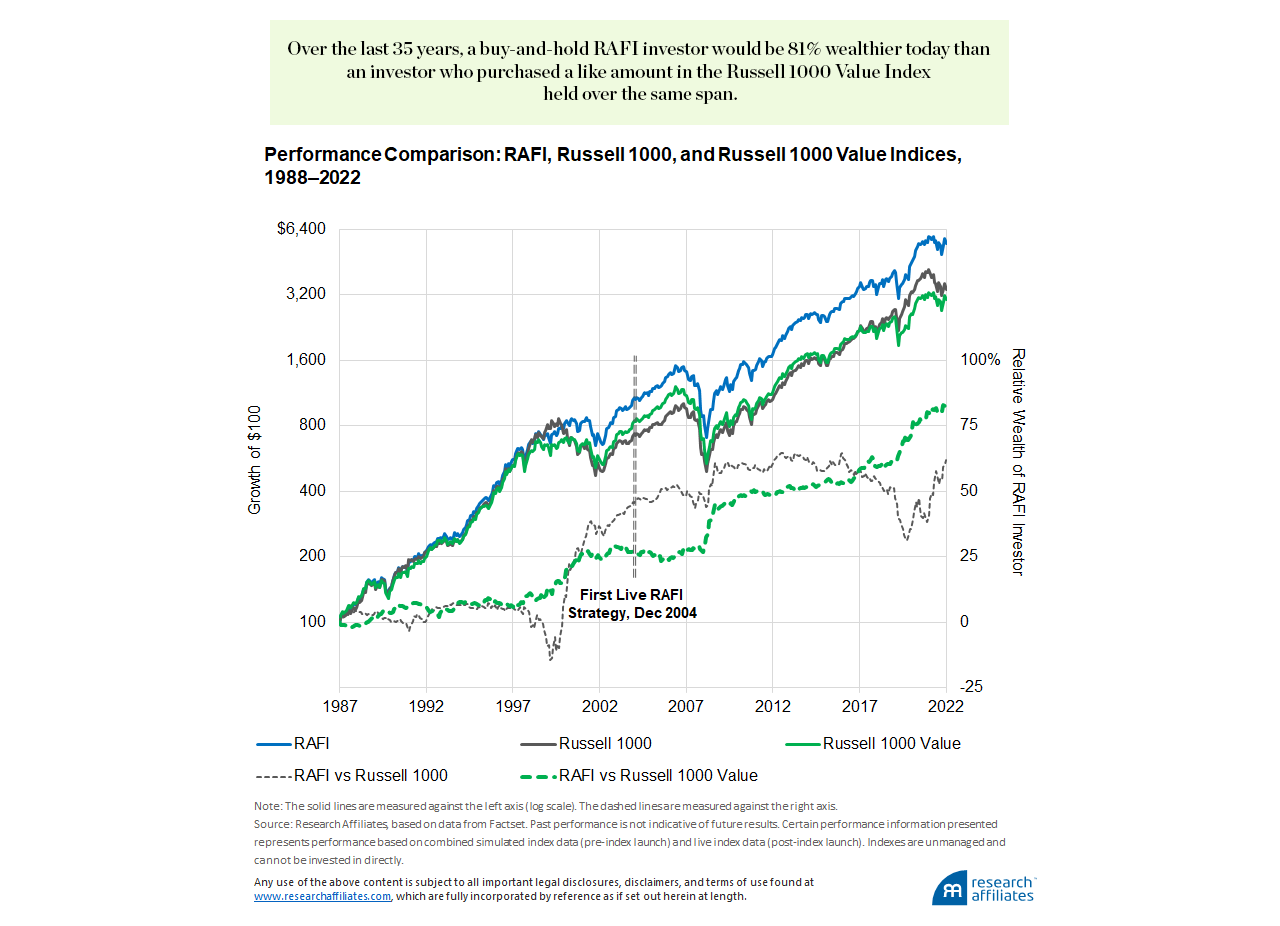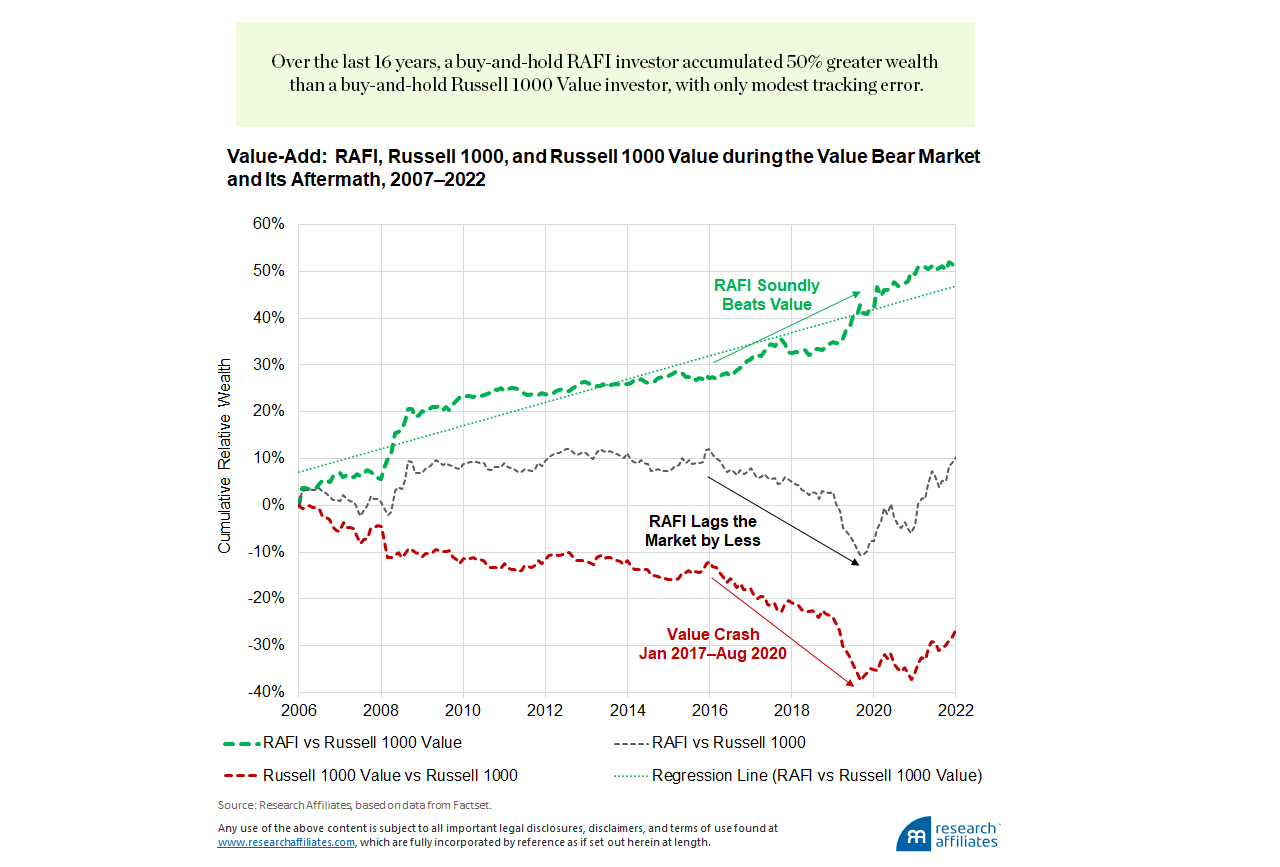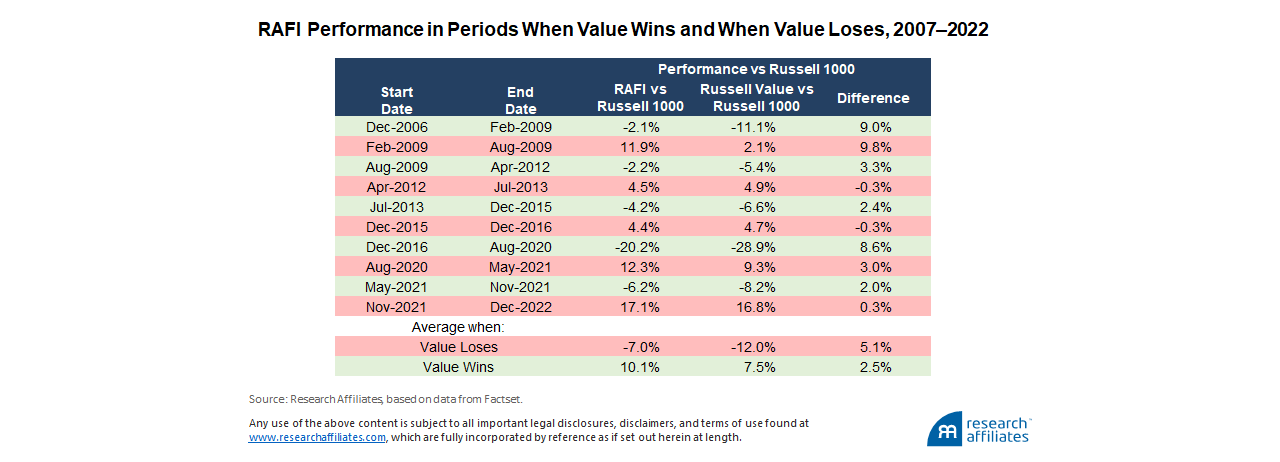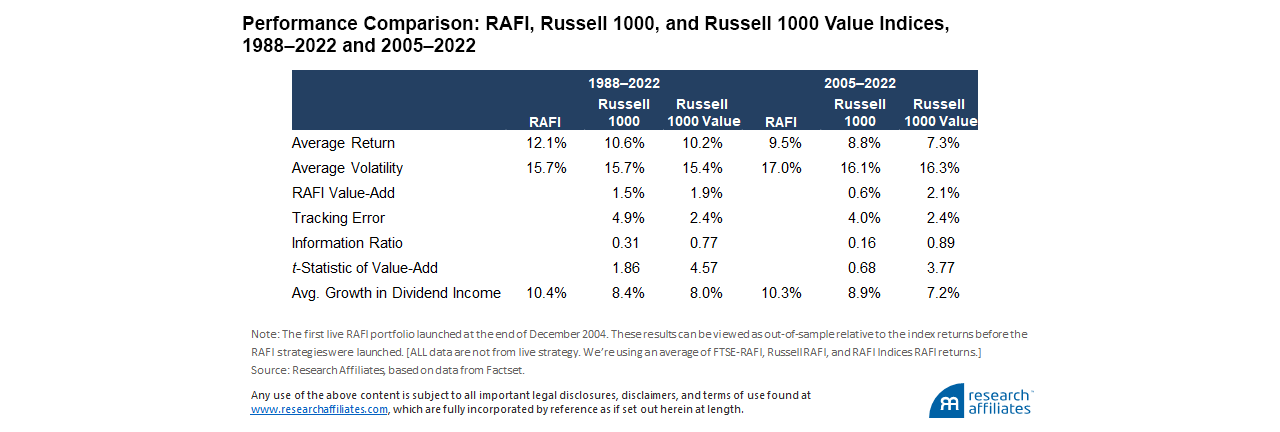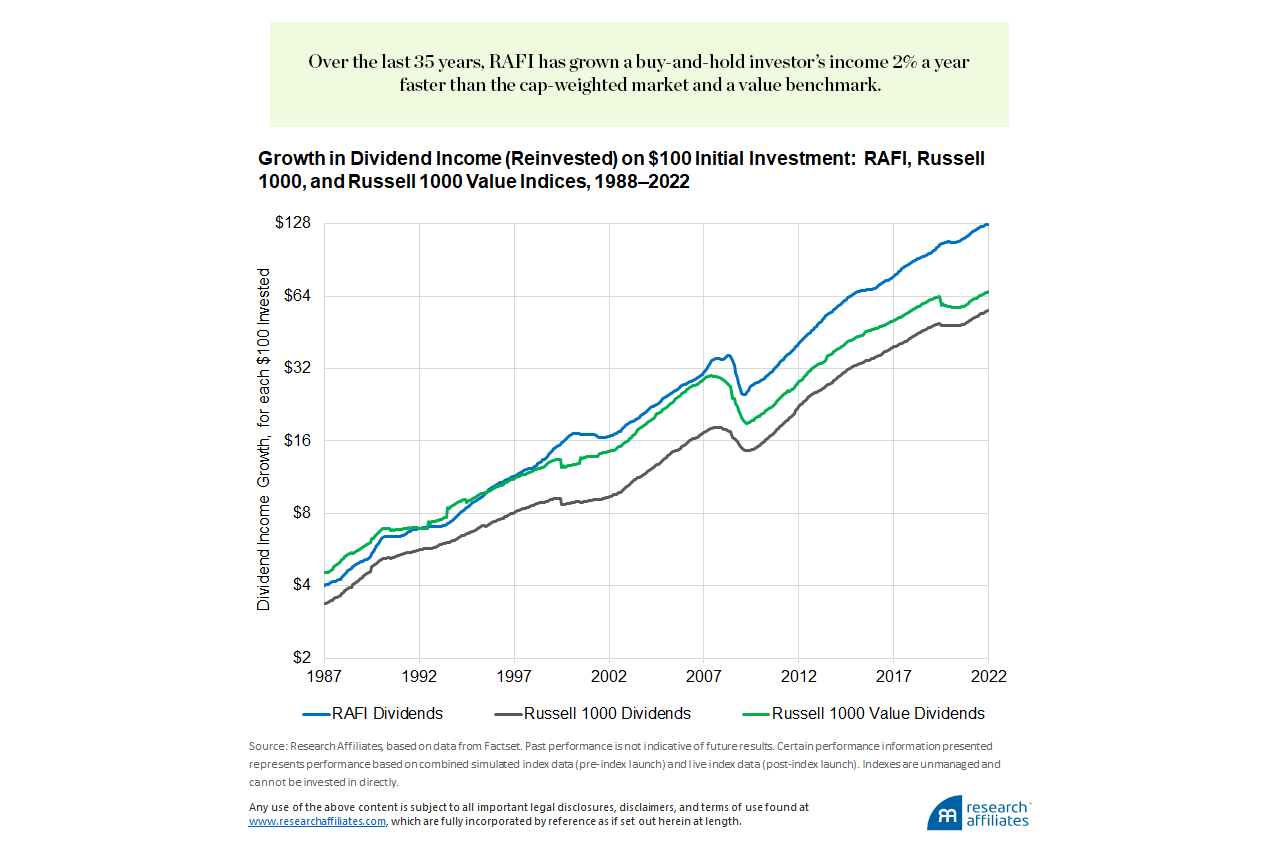
RAFI™, the original inspiration for the smart beta term, has produced consistently strong performance when measured against a style-equivalent, or value, benchmark. $100 invested in RAFI at the beginning of 1988 grew to $5,500 by yearend 2022, whereas the same amount invested in the Russell 1000 Value Index grew to $3,000 over the same time span.
Value stocks suffered four dramatic drawdowns since 1988, but—surprisingly—value companies did not falter, continuing to deliver dividend income growth to investors. RAFI investors enjoyed 2% higher average annual income growth than investors in either the cap-weighted market or a value benchmark.
From 1988 to 2022, RAFI fared better than conventional value investing during the biotech bubble and the 2008–2010 GFC and shrugged off the Covid crash almost entirely. If a better alternative to a cap-weighted strategy for a broad-market, low-turnover indexed portfolio exists, we believe it has yet to be identified.
With the blizzard of factor, quant, and niche strategies, it is easy to forget that the genesis of the term smart beta, coined by Towers Watson in 2007, was RAFI™, the Research Affiliates Fundamental Index.1 It was their (and our) view that RAFI wins by breaking the link between the price of a stock and its weight in the portfolio, so that overvalued stocks are not automatically overweighted relative to their unknowable future fair value, and vice versa, undervalued stocks underweighted versus their future fair value. When we break the link between price and portfolio weight, we earn rebalancing alpha from contra trading against any mean-reverting errors in share price.2 It remains our view that this essential element of the strategy is the key to its performance potential and is central to the original definition of smart beta, as explained by Arnott and Kose (2014).
The asset management community quickly appropriated the term, applying it to a myriad of strategies—some smart, some not, some simple, some complex. Even so, to this day, RAFI arguably remains the best of the smart beta strategies. More specifically, RAFI is likely the best way to access value investing in the global capital markets through the strategy’s utterly relentless history of adding value relative to cap-weighted value indices and its relentless ability to add Fama–French alpha, adjusted for style tilt, relative to the broad market.
In recent years, the smart beta revolution has sputtered, partly because many of these strategies are not at all smart, and partly because a frothy, growth-dominated capitalization-weighted market did a pretty good job of beating almost all comers in the years leading up to the value nadir in the summer of 2020. But if we look back at the original inspiration for the smart beta term, we see that RAFI has produced consistently strong performance when measured against a style-equivalent benchmark.
It’s time to take a fresh look at an extraordinary idea.
Create your free account or log in to keep reading.
Register or Log in
RAFI versus Russell 1000 and Russell 1000 Value Indices
Looking back 35 years, a performance comparison of RAFI versus the Russell 1000 and Russell 1000 Value indices shows just how consistent RAFI’s performance has been versus a style-equivalent benchmark.
In the following chart, the most important line is the green dashed line, which shows exactly this comparison, RAFI’s value-add relative to the Russell 1000 Value Index. What else can we learn from this performance graph?
- If an investor had invested $100 in the Russell 1000 Index at yearend 1987 (solid black line), their portfolio would be worth just under $3,400 by yearend 2022 (assuming dividends are reinvested and no fees, trading costs, or taxes are incurred along the way).
- If an investor had invested a like amount at the same time in the Russell 1000 Value Index (solid green line), their portfolio would have delivered a bit less, with their wealth growing to $3,000 over the same span.
- Meanwhile, an investor who chose to invest the same amount on the same date in RAFI would have accumulated just under $5,500 in their portfolio (solid blue line).
- Stated in relative terms, an investor in RAFI would have finished the 35-year period 62% wealthier than the Russell 1000 investor (dashed black line) and 81% wealthier than the Russell 1000 Value investor (dashed green line).
So far, so good.
The black dashed line in the preceding chart shows that RAFI would have outpaced the Russell 1000, but all the gains were earned from 2000 until 2009 and from mid-2020 to date—not a result that inspires confidence. It turns out that this episodic success is entirely a function of the value-growth cycle. Value had two meltdowns of 2,000 basis points (bps) each in relative wealth: 1) during the dot-com bubble in the late 1990s and 2) from 2017 through August 2020. Relative to the cap-weighted market, RAFI could mitigate these value meltdowns, but its value tilt relative to the market did not permit RAFI to keep pace with growth-dominated bubbles. RAFI chalked up gains of nearly 6,000 bps in the 2½ years after the dot-com bubble burst, approximately 1,200 bps in the aftermath of the global financial crisis (GFC), and 2,200 bps from the summer of 2020 until yearend 2022.3 From 1988 to 1995 and from 2002 to 2016, RAFI was marking time, winning by just over 100 bps a year during these spans.
RAFI usually beats value when value is winning—and when value is losing!
”In contrast, RAFI’s performance relative to the Russell 1000 Value Index (green dashed line), is an undeniable success. RAFI’s daunting drawdowns, from 1996 to 2000 and from 2017 to 2020, are entirely due to the challenges faced by value stocks. Relative to the Russell value index, RAFI won during both of these drawdowns, and over the last 35 years, never lagged the Russell value index by even 5%, peak to trough.
Over the same 35-year horizon, the Russell 1000 Value Index lagged the Russell 1000 broad-market index by 12%. RAFI, however, excelled in the value space by such an immense margin, the RAFI investor finished the period 62% richer than an investor in the Russell 1000. In effect, the experience from 1988, and the live experience from 2005 (US RAFI launched as a live strategy at yearend 2004), shows a value-tilted strategy winning big relative to the market, during a time span when value was losing!
The Value Rout of 2007–2020
Investors in conventional value strategies struggled for 13½ years, from early 2007 until the summer of 2020. Investors in RAFI fared far better, beating the Russell 1000 modestly until yearend 2016. But because of its value tilt, RAFI could not shrug off value’s travails in an increasingly frothy market. Whereas we can (and do) show that RAFI performed well net of its style tilts, investors cannot spend risk-adjusted returns and rarely applaud strategies that lose less than a disappointing peer group.
Generally, RAFI lags relative to the broad market only when the Russell 1000 Value Index is severely underperforming the Russell 1000 broad-market index. When value is winning, RAFI is usually winning by even more. In other words, RAFI wins when value wins and struggles when value loses.
All the lines in the following chart are dashed to indicate they track relative performance, not total returns, between RAFI and Russell 1000 Value, between RAFI and Russell 1000, and between Russell 1000 Value and Russell 1000. Note that the cumulative wealth of the RAFI investor against the Russell 1000 investor (black) rises and falls with the performance of the Russell 1000 Value Index against the Russell 1000 Index (red). The two lines are joined at the hip in terms of their movements up and down.
The gap between the two lines (red and black) grows relentlessly, however, especially during times of tumult such as 2008–2009 and 2020–2022. The dashed green line captures the relative wealth advantage of RAFI compared to the Russell 1000 Value Index. After the last 16 years (2007–2022), the RAFI investor is over 50% wealthier than the Russell 1000 Value investor, with only modest tracking error; note how closely the dashed green value-add line hugs the regression line. RAFI’s batting average is self-evidently exceptional, beating Russell 1000 Value in 13 out of 16 years and in all rolling three-year spans. The predominant pattern is simple: RAFI usually beats value when value is winning—and also usually beats value when value is losing!
From 2007 until the summer of 2020, value underperformed the market and underperformed growth, by the largest margin in history, eclipsing even the brutality (for value) of the dot-com bubble. From the March 2007 peak to the August 2020 trough, the Russell 1000 Value investor lost 37.5% in wealth relative to the Russell 1000 investor. The value rout was hardly linear. Its span encompassed five cycles in which either RAFI or Russell Value gained, then lost, at least 4% relative to the broad-market Russell 1000.
We can clearly see this pattern in the following table:
From 2007 through 2022, RAFI beat Russell 1000 Value in 8 of the 10 up or down legs of relative performance, winning by 200 to 1,000 bps in 7 of the 10. Why would any investor not choose RAFI for their value allocation?
Why a Value Benchmark?
In the early days of RAFI, we positioned the strategy as a legitimate alternative to a cap-weighted strategy, arguably likely to perform far better over long time periods, thereby tacitly encouraging comparisons with a broad market benchmark.4 This view is embraced by our largest RAFI partner, Charles Schwab (Tierney, 2022). We have always emphasized, however, that RAFI has a stark value tilt relative to the cap-weighted market, reweighting growth stocks down and value stocks up relative to the market. We enjoy the observation that RAFI is an active value strategy relative to the market, and the market is an active growth strategy relative to the macroeconomy, a topic we will revisit shortly.
Indeed, whenever value is out of favor and unusually cheap relative to the market, the tilt is often even stronger than the value tilt of value indices. This trait is surprising to many, because the growth darlings (e.g., in the current cycle, the FANG+ stocks5) are excluded from the value indices, but are not excluded from RAFI. That said, unlike the value indices, RAFI reweights value stocks up by a greater amount if their discount is deeper. As a result, RAFI has a far smaller tracking error relative to value indices and far more reliable excess performance. The following table tells RAFI’s compelling story:
We are trained to view the world of investing from a cap-weighted market perspective (hat tip to Bill Sharpe and Eugene Fama). But stocks are investments in businesses, each priced to reflect consensus expectations for the future prospects of those businesses. So, it is instructive to also view the world of investing from an economy-centric perspective. We describe this combined approach as applying binocular vision, which allows us to garner a richer 3-D view of the investing world. We can compare the three viewpoints as follows:
- From an economy-centric worldview, RAFI is studiously neutral, a passive index, while the cap-weighted market is a growth-tilted, momentum-chasing, popularity-weighted active portfolio, constantly changing composition as it follows the shifts in market sentiment about where the best future opportunities lie.
- From a cap-weighted worldview, RAFI is an active strategy, with dynamic style or factor tilts, including a very strong value tilt, a moderate anti-momentum tilt, and a mild small-cap and anti-quality tilt. In contrast, a broad cap-weighted market index studiously mirrors the look and composition of the stock market.
- From a binocular vision perspective, both RAFI and a cap-weighted strategy are simultaneously active and passive. On the one hand, cap-weight is a neutral, passive choice, implicitly seeking to reflect the economy many years in the future. On the other hand, it is a growth-biased active strategy relative to the present macroeconomy. While RAFI studiously mirrors the look and composition of the present publicly-traded economy, it is active relative to the cap-weighted market.
A cap-weight-centric worldview leads many to reject the merits of non-cap-weighted indices. A willingness to view the world from both a cap-weight-centric and an economy-centric perspective suggests both benchmarks matter. When we view RAFI as an alternative to, or as a complement to, a cap-weighted broad market index, its performance relative to the market is relevant. When we consider the style or factor attributes of RAFI, relative to the cap-weighted market portfolio, it becomes very clear that a value index is the relevant benchmark for RAFI itself.
The Myth of the Value Rout
Value stocks underperformed growth stocks severely in those years, especially in the meltdown of 2017–2020. But—shockingly—value companies did not! In our award-winning article “Reports of Value’s Death May Be Greatly Exaggerated”6 published in Financial Analysts Journal (Arnott, et al., 2021), we debunked the notion that value failed investors from 2007 to 2020. The underpinnings of a company’s value are financial measures such as sales, profits, net worth, dividends, and buybacks, which grew faster for value portfolios than for growth portfolios. If value and growth stocks traded at the same relative valuation multiples as they did in 2007, value would have outperformed growth.
From 1988 through 2022, value stocks suffered four double-digit routs, but value companies did not. The four routs that value stocks had to contend with were the
- The biotech bubble, from December 1988 through 1991, when value underperformed by 14%;
- The dot-com bubble, from January 1998 until February 2000, when value’s shortfall was 24%;
- The global financial crisis, from August 2007 until March 2009, when value’s performance gap was just over 10%; and
- The FANG+ bubble, from August 2013 until August 2020, when value lagged by over 30%.7
None of these saw value companies struggle nearly to the extent of value stocks; indeed, in the first one, value companies out-grew growth companies! As a measure of how well value companies performed over the last 35 years, we compare how investors in RAFI and the Russell 1000 and Russell 1000 Value indices fared in terms of dividend income.
A Russell 1000 investor who invested $100 at yearend 1987 bought an index with a dividend yield of 3.36%. Initially, the portfolio delivered $3.36 in annual income. If the dividends were reinvested, and if the investor enjoyed the full total return of the Russell 1000 (with no fees, trading costs, or taxes), the portfolio would deliver an impressive $55 in annual income by the end of 2022!
Stocks for the long run, indeed.
An investor in the Russell 1000 Value Index might reasonably have expected a higher starting yield and slower growth, so that the net present value of the income stream would match that of the Russell 1000. As expected, the value investor earned a higher starting yield (4.52%, against 3.36% for the broad market, or dividends of $4.52 a year), but surprisingly did not get slower growth. After 35 years, the Russell 1000 Value investor still earns more than the Russell 1000 investor, at $66 a year.
So, how did the RAFI investor fare? Acknowledging that RAFI did not yet exist in 1988, our hypothetical RAFI investor began with income just under that of the conventional value investor, at $4.01. But after 35 years, annual dividend income grew to a whopping $128 for every $100 invested at yearend 1987.
Over our 35-year analysis period, RAFI grew an investor’s income 2% a year faster than the cap-weighted market. Since 1988, RAFI’s annual growth in dividend income is 10.4%, while the annual income growth of the Russell 1000, Russell value, and (interestingly) Russell growth indices are tightly clustered at 8.4%, and 8.0%, respectively.8
RAFI, Russell 1000, and Russell 1000 Value all enjoyed steady income growth since 1987, with a small dip for value in the summers of 2000 and 2020 from rebalancing, and a noteworthy dip due to dividend cuts—particularly serious for the cap-weighted Russell value index—in 2008 and 2009 during the GFC. Did these dips in income, relative to the dividends of the Russell 1000, bear any resemblance to the double-digit underperformance of value stocks during these routs? Hardly.
Value investors’ income rose by 8% less than the broad market during the biotech bubble, by 5% more in the dot-com bubble, by 6% less in the GFC, and by a scant 5% less than Russell 1000 investors during the FANG+ bubble. In other words, during double-digit routs for value investors when value stocks’ total returns lagged the broad market by an average of 20%, value stocks’ dividends—a core underpinning of value for these companies—lagged the income growth of the Russell 1000 investor by an average of only 3.5%. The market was clearly pricing value for an average of six times the damage actually experienced.
RAFI fared far better, with its income growth beating that of the Russell 1000 and Russell 1000 Value in all four of the value routs. RAFI stocks’ dividend distributions rose by 2% more than those of the Russell 1000 during the biotech bubble, by 15% more in the dot-com bubble, by 17% more in the GFC, and by over 20% during the FANG+ bubble. Even though RAFI’s fundamental value measures (sales, cash flow, dividends, and book value) improved relative to those of the stocks in the Russell 1000 by an average of over 13% in each of the four routs, RAFI’s portfolio of stocks underperformed the market on average by double digits.
Relative to conventional value indices, RAFI has a far smaller tracking error, far more reliable value-added, and an enviable batting average.
”The last of the four routs merits special mention. The value meltdown from 2017 until August 2020 was worse relative to the Russell 1000 than the rout during the dot-com bubble. In the most recent rout, however, the income on the RAFI portfolio rose nonstop relative to the income on the Russell 1000, even as RAFI’s total return took a 20% hit. This result invites the question: What were investors thinking when they continually pummeled value stocks relative to the market? The entire drop in value stocks’ prices turned on an ultimately false narrative: the bubble stocks of the last decade would dominate the global economy for decades to come, while the value stocks would recede into obscurity. Of course, that’s the narrative of every bubble.
The market turbulence during the value routs offered many rebalancing opportunities. Fama and French (2019) showed that a rebalancing phenomenon helps value stocks and hurts growth stocks.9 Some value stocks come back into favor and are promoted out of the value index, only to be replaced with a deeper-value name. This process delivers a step up in an investor’s earnings, dividends, sales, and net worth per $100 of portfolio value. Growth experiences the opposite impact in rebalancing. When a growth stock falls out of favor and is demoted out of the growth portfolio, it is typically replaced with a frothy new highflier. Thus, for every $100 of portfolio value, each rebalancing of the portfolio delivers less profits, dividends, and so forth. This migration effect is almost always larger than the difference in growth rates between growth and value stocks.
The RAFI strategy, taking advantage of these opportunities, was able to grow dividend income 14.6% a year since 2007. In contrast, Russell 1000 posted 12.5% annual income growth, while the Russell value and growth indices chalked up income growth of 11.5% and 10.7% a year, respectively, held back by rebalancing issues, most particularly in 2008 and 2020. While we don’t show it in the graph, income growth for the growth investor is the slowest of the bunch due to rebalancing, as noted by Fama and French (2019). RAFI experienced no dip in income during the Covid crash and enjoyed faster growth than any of the cap-weighted indices over the full 35-year span of our study as well as over the “lost” decade for value that ended August 2020 and in the aftermath of Covid.
Because RAFI did not exist in 1988, how has the strategy performed since it went live at the end of 2004? Dividend income, reinvested in the strategy, grew 10.3% a year compared to 8.9% and 7.2% for the Russell 1000 and Russell 1000 Value indices, respectively. RAFI’s growth in dividend income exceeded that of the Russell 1000 by 1.4% a year over an investment horizon that was supposed to be terrible for value companies.
Here's a fun thought experiment. Suppose RAFI, Russell 1000, and Russell 1000 Value all trade at the same dividend yield over time. That would mean investors did not demand a different risk premium over time and that they did not prefer stocks in one strategy to those in another. In such a scenario, the lines in the preceding graph would be the actual total-return trajectories of the three strategies. An efficient market should be able to anticipate how a company’s prospects will change in the future. A market with perfect foresight would have clipped value stocks a little bit in the biotech bubble of the early 1990s and during the GFC, but a wise, all-knowing market would never have punished value stocks during the dot-com bubble or the 2017–2020 meltdown.
RAFI Still Rocks After All These Years!
The conventional view is that value stocks grow more slowly than growth stocks. They are cheap because the market believes they have weaker management, weaker profit margins, tougher competition, and/or other headwinds—and indeed they often do.10 Value stocks are already priced to reflect these headwinds, however, so their low prices give investors a margin of safety, whereas growth stocks are often “priced for perfection” with no room for disappointment.
Over our study period, the only times the Russell 1000 Value investor’s income faltered relative to the Russell 1000 investor’s were the modest relative growth hits during the biotech bubble and the 2020 Covid meltdown, and the noteworthy slump in income during (and after) the GFC from mid-2008 to mid-2010. RAFI fared better than conventional value investing during each of these periods and shrugged off the Covid crash almost entirely.
Yes, RAFI still rocks! If a better alternative to a cap-weighted strategy for a broad-market, low-turnover indexed portfolio exists, we believe it has yet to be identified. For those who insist on viewing RAFI as an active value strategy, we question whether a better broad-market, low-turnover value strategy has ever been developed.
Please read our disclosures concurrent with this publication: https://www.researchaffiliates.com/legal/disclosures#investment-adviser-disclosure-and-disclaimers.
Endnotes
1. For those unfamiliar with the strategy, RAFI simply selects and weights companies according to their macroeconomic scale, rather than their market capitalization. Much as conventional indexing assiduously tracks the look and composition of the stock market, RAFI assiduously tracks—and rebalances toward—the look and composition of the publicly traded macroeconomy. The three largest providers are FTSE RAFI and Russell RAFI (both offered by FTSE Russell) and our own RAFI Multi-Factor Index strategy, as well as other variants of the strategy. Arnott, Hsu, and Moore (2005) and Arnott, Hsu, and West (2008) provide a thorough explanation of the fundamental index strategy.
2. Towers Watson observed that other strategies, such as equal-weight, minimum-variance, and optimization-based, as long as they do not anchor on tracking error or sector weights relative to the cap-weighted market, can achieve the same contra-trading performance impact.
3. These calculations are based on the relative wealth of a RAFI investor versus the Russell 1000, assuming a start date of December 31, 1987.
4. We acknowledged RAFI’s stark value tilt from the beginning. We like the following thought experiment: Does RAFI have a value tilt, or does cap-weight have a growth tilt? Both are true. RAFI mirrors the look and composition of the macroeconomy, which is dominated by big value companies; the cap-weighted market is dominated by expensive growth companies, because they are presumed to eventually dominate the future economy. RAFI is value tilted relative to the market, and the market has a growth tilt relative to the macroeconomy.
5. At this writing, the FANG+ stocks has been defined to include the FANG stocks (Facebook/Meta, Amazon, Netflix, and Google), plus the winning survivors from the dot-com bubble (Apple, Advanced Micro Devices, and Microsoft), plus some of the newer frothy meme stocks (NVIDIA, Tesla, and Snowflake).
6. The CFA Institute awarded this article with the Graham and Dodd Scroll accolade in 2021.
7. The size of the rout is measured from new high-water marks in either Russell 1000 Value or RAFI relative to the Russell 1000 until Russell 1000 Value hits its trough relative to the Russell 1000. We use this approach because Russell 1000 Value had very few “new high-water marks” in relative performance against the market.
8. How is it that the Russell 1000’s dividend income growth exceeds that of the Russell value and growth indices? Value and growth indices have a subtle rebalancing nuance that can slightly erode (or boost) both portfolios’ dividend yields in some years relative to the broader Russell 1000. They rebalance in June each year. Imagine if growth beats the market by 20% and value lags by 20% from June of one year to June the next. The market will now be 60% growth/40% value. In addition to some companies coming into the Russell 1000, and some leaving, one-sixth of the growth stocks will be reassigned to value. This causes the dividend yields – hence income stream – for both the growth and value portfolios to drop materially, while the Russell 1000 experiences nothing of the sort. In fact, this is exactly what happened in June 2000 and again in June 2020.
9. Arnott and Chaves (2012) examined this phenomenon in their award-winning article, “Rebalancing and the Value Effect,” published in the Journal of Portfolio Management.
10. For research into this phenomenon, we refer you to Arnott, Li, and Sherrerd (2009a, 2009b).
References
Arnott, Robert, Campbell Harvey, Vitali Kalesnik, and Juhani Linnainmaa. 2021. “Reports of Value’s Death Are Greatly Exaggerated.” Financial Analysts Journal, vol. 77, no. 1 (First Quarter):44–67.
Arnott, Robert, Jason Hsu, and Philip Moore. 2005. “Fundamental Indexation.” Financial Analysts Journal, vol. 61, no. 2 (March/April):83–99.
Arnott, Robert, Jason Hsu, and John West. 2008. The Fundamental Index: A Better Way to Invest. Hoboken, New Jersey: John Wiley & Sons, Inc.
Arnott, Robert, and Engin Kose. 2014. “What ‘Smart Beta’ Means to Us.” Research Affiliates Fundamentals (April).
Arnott, Robert, Feifei Li, and Katrina Sherrerd. 2009a. “Clairvoyant Value and the Value Effect.” Journal of Portfolio Management, vol. 25, no. 3:12–26.
———. 2009b. “Clairvoyant Value II: The Growth/Value Cycle.” Journal of Portfolio Management, vol. 35, no. 4:142–157.
Chaves, Denis, and Robert Arnott. 2012. “Rebalancing and the Value Effect.” Journal of Portfolio Management, vol. 38, no. 4:59–74.
Fama, Eugene, and Kenneth French. 2019. “Migration.” Financial Analysts Journal, vol. 63, no. 3:48–58.
Tierney, D.J. 2022. “Time to Return to Fundamentals?” Charles Schwab.com (August 17).
Important Information
Past performance is not a guarantee of future results. Certain performance information presented in the article represents simulated performance or performance based on combined simulated index data (pre-index launch) and live index data (post-index launch). Indexes are unmanaged and cannot be invested in directly. Past simulated performance is no guarantee of future performance and does not represent actual performance of an investment product based on an index. No allowance has been made for trading costs, management fees, or other costs associated with asset management, as the information provided relates only to the index itself. Actual investment results will differ.

